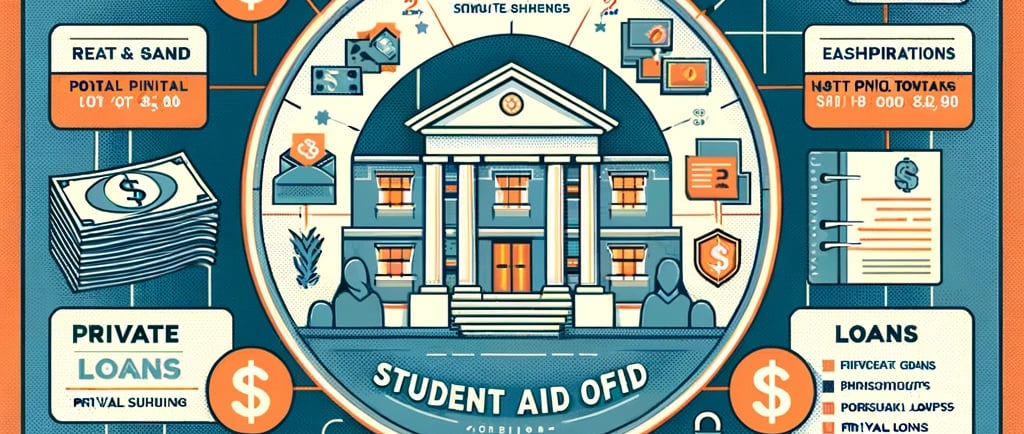How to Evaluate Student Aid Offers: A Comprehensive Guide for Parents
Confused by the financial aid offers you received? Read this guide to help you break down what you are looking at and help you effectively understand what you are actually working with.
COLLEGE EDUCATIONFINANCIAL WISDOM
7/26/20247 min read


Congratulations! Your child has been accepted to multiple colleges, but now comes the challenging part: evaluating the student aid offers. These letters can be confusing, with various terms and numbers that might not be immediately clear. This guide will help you understand what each offer entails, how to compare them, and what steps to take next.
Understanding Financial Aid Offers
Financial aid offers generally consist of a mix of grants, scholarships, loans, and work-study opportunities. Here's a detailed breakdown:
Grants and Scholarships (Gift Aid)
Federal Pell Grant: This need-based grant is awarded to students with significant financial need. The maximum award for the 2024-2025 academic year is $7,395. To qualify, families typically need a very low Student Aid Index (SAI).
Federal Supplemental Educational Opportunity Grant (FSEOG): Awarded to students with exceptional financial need, these grants are limited and awarded on a first-come, first-served basis and offer limited amounts of aid.
State Grants: Many states offer grants based on financial need. Check your state's deadlines and requirements.
Institutional Scholarships: These are awarded by colleges and can be based on merit, need, or specific talents. Note that some institutional aid may only be for the first year, so check the renewal criteria for subsequent years.
Loans (Self-Help Aid)
Federal Direct Subsidized Loan: Available to undergraduates with financial need, these loans do not accrue interest while the student is in school at least half-time, during the grace period, or during deferment periods. The current interest rate for 2024-2025 is 6.53% (The College Investor) (Money).
Federal Direct Unsubsidized Loan: Available to all undergraduates, these loans accrue interest from the time they are disbursed. The interest rate for 2024-2025 is 6.53% for undergraduates and 8.08% for graduate students (Money) (Juno).
Parent PLUS Loan: Federal loans available to parents of dependent undergraduate students. These loans require a credit check and have an interest rate of 9.08% for 2024-2025 (The College Investor) (Money). Repayment starts immediately unless deferred.
Private Loans: These loans are offered by private lenders and can have fixed or variable interest rates. They often require a co-signer and may not offer the same protections as federal loans. Rates can vary widely, typically ranging from 4.5% to 16.5% for fixed rates and 5.5% to 18% for variable rates (Juno).
Work-Study Programs
Federal Work-Study: Provides part-time jobs for students with financial need. These jobs typically pay minimum wage and are meant to help cover personal expenses (The College Investor).
Steps to Evaluate and Compare Offers
Evaluating financial aid offers can be overwhelming, but here are the steps to make it more manageable:
Calculate the Net Price The net price is the total cost of attendance minus grants and scholarships. This is the actual amount you will need to pay out-of-pocket or through loans and other means. Use this formula: Net Price=Total Cost of Attendance−Grants and Scholarships
Total Cost of Attendance (COA): Includes tuition, fees, room and board, books and supplies, transportation, and personal expenses.
Tuition and Fees: This includes the cost of classes and other mandatory fees that the college charges. Fees can cover a range of things, such as lab usage, library access, and student activities.
Room and Board: This covers the cost of living on campus, including housing and meal plans. If your child lives off-campus, this would include rent and food expenses.
Books and Supplies: The estimated cost for textbooks, lab materials, and other necessary supplies for courses.
Transportation: This includes the cost of traveling to and from the college, which might involve airfare, gas, public transportation, or other travel-related expenses.
Personal Expenses: These are miscellaneous costs that cover personal items, such as clothing, toiletries, entertainment, and other non-essential but common living expenses.
Miscellaneous Fees: This might include health insurance, technology fees, and other specific charges that vary by institution.
Grants and Scholarships
Federal Grants: Need-based grants from the federal government, such as the Pell Grant, that do not need to be repaid.
State Grants: Financial aid provided by the state government, often based on financial need or merit.
Institutional Scholarships and Grants: Funds awarded by the college itself, which can be based on academic merit, athletic ability, artistic talent, or financial need.
Private Scholarships: Awards from private organizations, non-profits, or corporations, often based on merit or specific criteria set by the awarding body.
Calculating the Net Price
Step 1: Total Cost of Attendance (COA): Add up all the costs associated with attending the college (tuition, fees, room and board, books, transportation, personal expenses, and miscellaneous fees).
Step 2: Subtract Grants and Scholarships: Deduct the total amount of grants and scholarships from the COA.
Result: Net Price: The remaining amount is the net price, which is the actual amount you and your family will need to cover through savings, income, loans, or other financial resources.
Example Calculation
Assume the following costs for one year at a college:
Tuition and Fees: $30,000
Room and Board: $10,000
Books and Supplies: $1,200
Transportation: $1,000
Personal Expenses: $2,000
Miscellaneous Fees: $800
Total Cost of Attendance (COA): Tuition and Fees + Room and Board + Books and Supplies + Transportation + Personal Expenses + Miscellaneous Fees = $45,000
Assume the student receives the following grants and scholarships:
Federal Pell Grant: $5,000
State Grant: $2,000
Institutional Scholarship: $10,000
Private Scholarship: $3,000
Total Grants and Scholarships: Federal Pell Grant + State Grant + Institutional Scholarship + Private Scholarship = $20,000
Net Price Calculation: $45,000(COA)−$20,000(Grants and Scholarships=$25,000
This $25,000 is the amount the family needs to cover through other means such as savings, loans, work-study, or additional scholarships.
Understand Loan Terms
Interest Rates: Subsidized loans have no interest while in school, while unsubsidized loans accrue interest from day one. Parent PLUS loans have higher interest rates compared to federal student loans and interest starts from the day the loan is disbursed.
Repayment Terms: Federal loans offer more flexible repayment plans compared to private loans. Check if the loans are fixed or variable rate as well as when the interest starts accumulating.
Borrowing Tips: It is not uncommon for people to borrow maximum amount and get reimbursed during the student’s freshman year. Instead of taking that check and making your loan bigger, you can return it and work with Financial Aid Officer at your child’s school to make adjustment. Goal is to borrow absolute minimum you need to get the education.
Examine Work-Study Details Work-study awards are not guaranteed jobs. Students must secure and keep eligible positions and balance work with their studies. Remember that it typically pays minimum wage only and it doesn’t cover all educational costs.
Key Considerations
Compare Financial Aid Packages: Create a comparison chart listing each school's total cost of attendance, grants, scholarships, loans, and work-study amounts. Calculate the net price for each school and consider the types and conditions of aid. Ensure you understand the terms of any loans offered and consider the long-term impact of debt.
Review Additional Costs: Besides tuition, room and board, plan for textbooks, supplies, transportation, personal expenses, and additional fees. These costs can vary widely between schools, so it's important to budget realistically and factor them into your overall cost calculations.
Appeal If Necessary: If your financial situation has changed or if you have received a better offer from another school, you can appeal for more aid. Write a formal appeal letter to the financial aid office explaining your circumstances or presenting the competing offer. Be respectful and provide supporting documentation to make your case.
Practical Tips
Look Beyond Sticker Price: A higher-cost school might be more affordable after aid and discounting. Use the net price calculation to understand your actual costs. You may be pleasantly surprised that more expensive school may be more affordable to you and your family.
Plan for the Long Term: Consider the total amount of debt and your child’s expected income post-graduation. Use resources like the Occupational Outlook Handbook to research potential earnings and also look at graduation rates and support that alumni receive from their alma mater.
Balance Financial Aid with Family Contributions: Ensure that contributing to college expenses does not compromise your financial stability or retirement savings. While some loans may be necessary and even good, especially for your child to start building their credit score, excessive amounts can be detrimental for years to come.
Common Questions and Detailed Answers
Q: What does the "self-help" section mean?
A: The "self-help" section includes loans and work-study opportunities. Unlike grants and scholarships, which do not require repayment, self-help aid involves either borrowing money or working part-time. Work-study jobs are not guaranteed; students must find and apply for positions. The income from work-study is meant to help with educational expenses, but it might not cover all costs.
Q: How do I compare different financial aid offers effectively?
A: Create a comparison chart listing each school's total cost of attendance, grants, scholarships, loans, and work-study amounts. Calculate the net price for each school and consider the types and conditions of aid. Ensure you understand the terms of any loans offered and consider the long-term impact of debt.
Q: What should I consider about loan terms?
A: Focus on the interest rates, whether the loans are subsidized or unsubsidized, and repayment terms. Subsidized loans are more favorable as they do not accrue interest while the student is in school. Compare the total amount of debt your child will incur and their potential income after graduation to ensure the debt is manageable.
Q: Can I negotiate a financial aid offer?
A: Yes, if your financial situation has changed or if you have received a better offer from another school, you can appeal for more aid. Write a formal appeal letter to the financial aid office explaining your circumstances or presenting the competing offer. Be respectful and provide supporting documentation to make your case.
Q: What additional costs should we plan for?
A: Besides tuition, room, and board, plan for textbooks, supplies, transportation, personal expenses, and additional fees. These costs can vary widely between schools, so it's important to budget realistically and factor them into your overall cost calculations.
Conclusion
Evaluating student aid offers can be daunting, but by breaking down each component and comparing net prices, loan terms, and work-study opportunities, you can make an informed decision. Remember, the goal is to minimize debt while ensuring that your child receives a quality education.
For more detailed information on understanding and evaluating financial aid offers, check out resources from Federal Student Aid.
By following these steps and asking the right questions, you can ensure that your child’s college journey is financially manageable and successful. For personalized advice, consider working with a financial planner.
Subscribe to The Wealthy Elephant Corner Blog
Stay updated with the latest financial insights and strategies from The Wealthy Elephant Corner. Subscribe to our blog and receive exclusive content, expert tips and valuable advice delivered right to your inbox. Join our community of financially savvy individuals and embark on your financial journey to financial wisdom today.
©2024-2025 Elephant Corner Financial. All Rights Reserved.
145 Pine Haven Shores, Suite 1000-101, Shelburne, VT 05482
